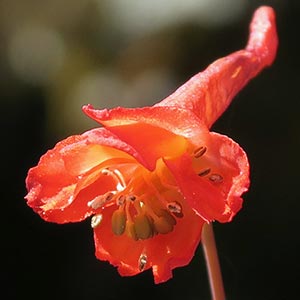Delphinium nudicaule
Delphinium hutchinsoniae
canyon delphinium, canyon larkspur, orange larkspur, red larkspur, red or orange larkspur, scarlet larkspur
Hutchinson's delphinium, Hutchinson's larkspur, Monterey larkspur
(15-)20-50(-125) cm;
base reddish, glabrous.
(25-)50-80(-100) cm;
base reddish, not longitudinally ridged, variably puberulent.
blade round to pentagonal, 2-6 × 3-10 cm; ultimate lobes 3-12, width 5-40 mm (basal), 2-20 mm (cauline).
blade round to pentagonal, 1-6 × 1.5-10 cm, puberulent; ultimate lobes 3-17, width 4-16(-25) mm (basal), 1-8(-19) mm (cauline).
5-20(-69)-flowered;
pedicel (1.5-)2-6(-8) cm, glabrous to glandular-pubescent;
bracteoles 14-20(-30) mm from flowers, green to red, linear, 2-4(-9) mm, glabrous to puberulent.
(2-)7-20(-31)-flowered, open;
pedicel 1-4(-6) cm, puberulent;
bracteoles (2-)8-12 mm from flowers, green, linear, 3-6(-9) mm, puberulent.
sepals scarlet to reddish orange, rarely dull yellow, glabrous, lateral sepals forward-pointing to form pseudotube, (6-)8-13(-16) × 3-6 mm, spurs straight, slightly ascending, (12-)18-27(-34) mm;
lower petal blades elevated, exposing stamens, 2-3 mm, clefts 0.5-1 mm;
hairs sparse, evenly dispersed, yellow.
sepals dark bluish purple, puberulent, lateral sepals spreading, (12-)14-19(-24) × 7-12(-15) mm, spurs ascending, decurved apically, 11-19 mm;
lower petal blades slightly elevated, mostly covering stamens, 5-10 mm, cleft 2-3 mm;
hairs sparse, mostly on inner lobes, absent on margins, white.
13-26 mm, 3.5-4.5 times longer than wide, glabrous.
9-21 mm, 2.5-4.2 times longer than wide, sparsely puberulent.
unwinged or sometimes slightly wing-margined;
seed coat cells with surfaces smooth.
not echinate, ± smooth to naked eye;
seed coat cells with margins ± undulate, surfaces smooth.
= 16.
Delphinium nudicaule
Delphinium hutchinsoniae
Delphinium nudicaule hybridizes with most other taxa of Delphinium that it encounters. Apparent hybrids involving D. nudicaule, and seen by the author (either afield or as specimens), include D. andersonii, D. antoninum, D. decorum, D. luteum, D. nuttallianum, D. patens, and D. trolliifolium. In addition, garden-grown plants have been hybridized with D. cardinale, D. elatum, D. menziesii, D. parishii, D. penardii, D. tatsienense Franchet, D. triste Fischer ex de Candolle, and D. uliginosum; D. nudicaule does not naturally occur with these species. Delphinium nudicaule is one of the earliest larkspurs to flower in any given locality. Douglas's type collection of D. nudicaule represents plants (synonyms D. sarcophyllum Hooker & Arnott and D. peltatum Hooker, an invalid name) grown under very moist conditions, probably quite near the ocean. The type specimen of D. armeniacum A. Heller represents plants grown under unusually dry conditions.
The Mendocino Indians consider Delphinium nudicaule a narcotic (D. E. Moerman 1986).
(Discussion copyrighted by Flora of North America; reprinted with permission.)
Of conservation concern.
Delphinium hutchinsoniae is known from only a few populations near Monterey and south to the Big Sur region. Hybrids have been produced between D. hutchinsoniae and D. cardinale grown in a common garden. Hybrids also occur with D. parryi subsp. maritimum.
Delphinium hutchinsoniae is similar, and probably closely related, to D. variegatum. The two may be distinguished by the decurved spur of D. hutchinsoniae; the spur of D. variegatum is normally straight (or decurved nearer apex). Delphinium hutchinsoniae lacks marginal hairs on lower petals; such hairs are present in D. variegatum. The two species are also geographically separated.
(Discussion copyrighted by Flora of North America; reprinted with permission.)


